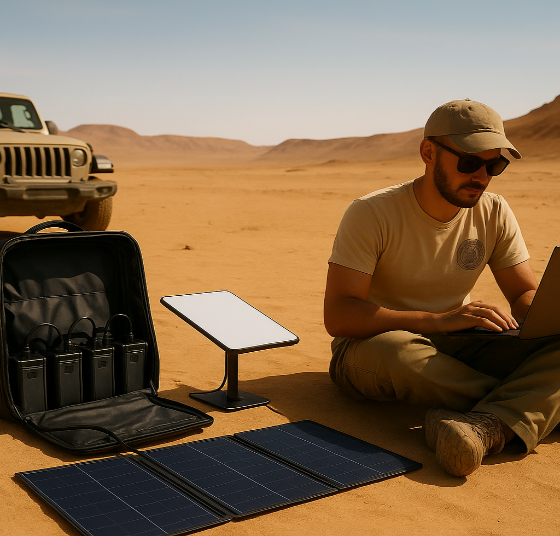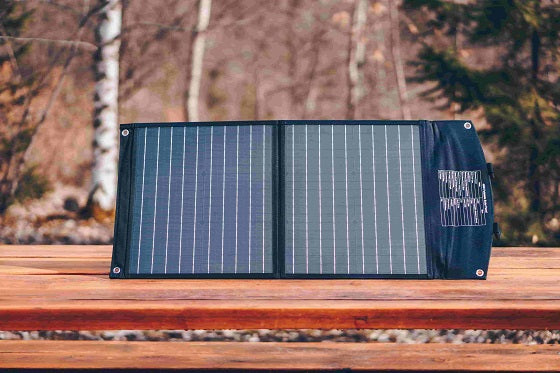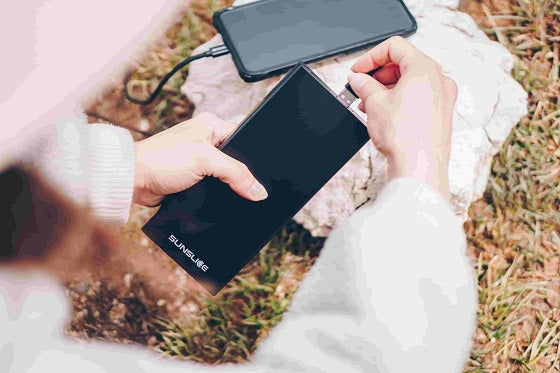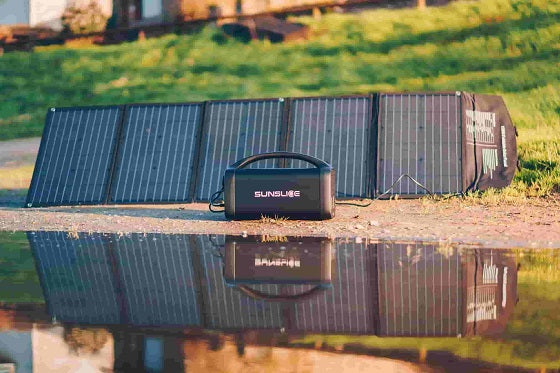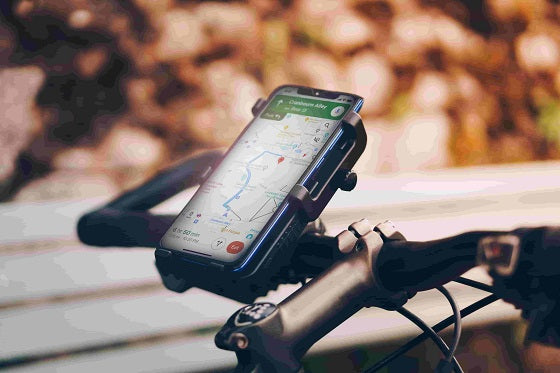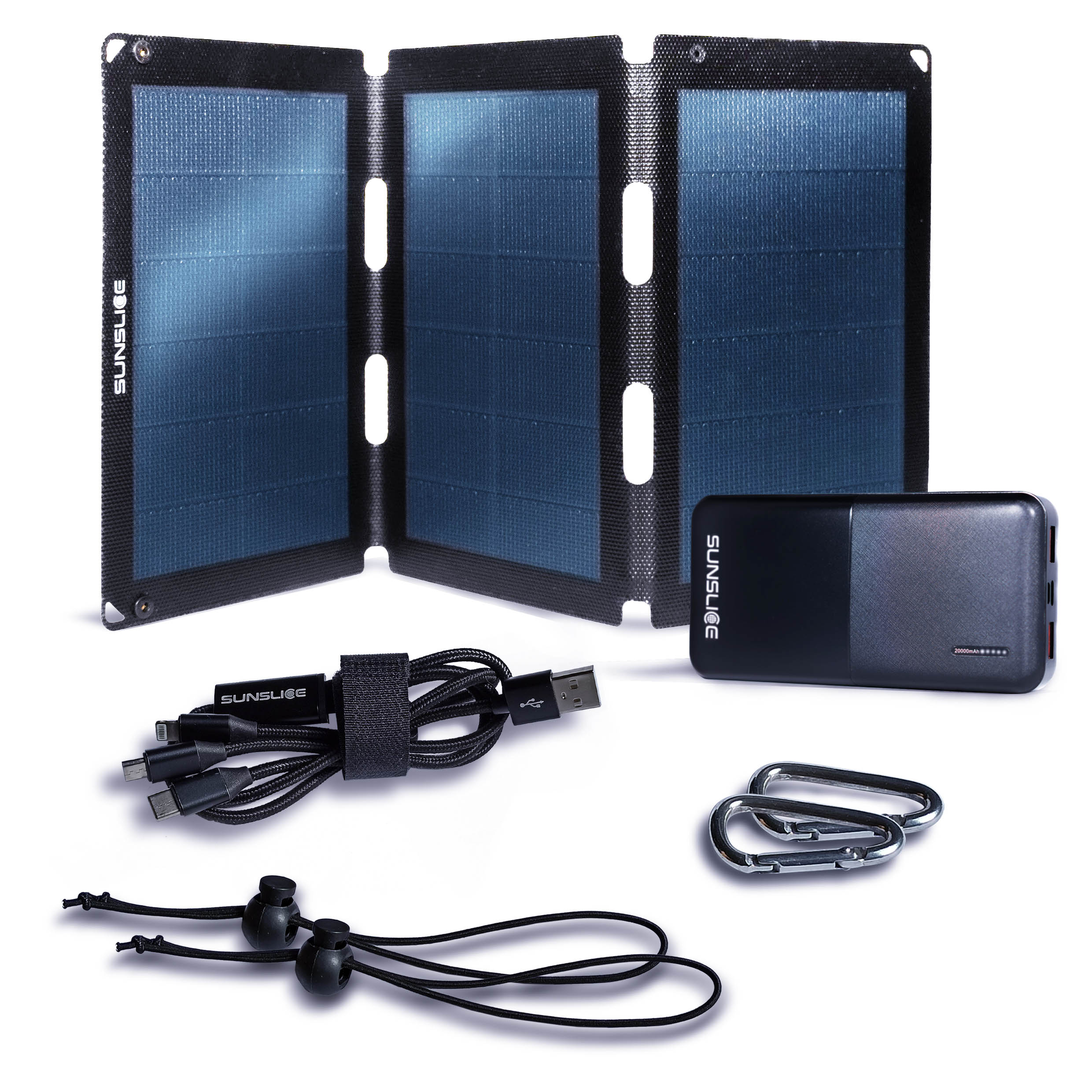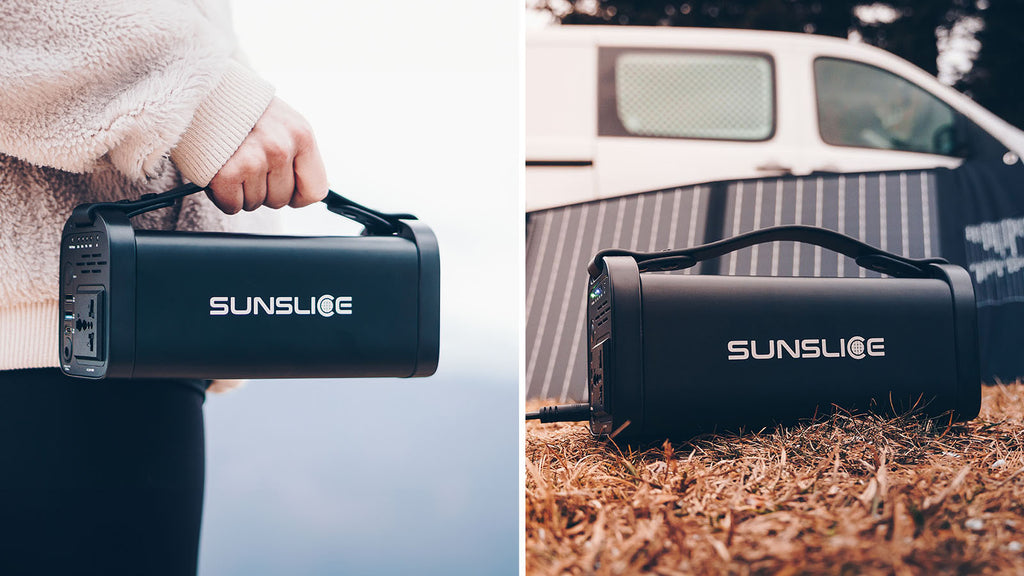The Solar Panel and the battery: the Complete Guide
Solar power is on the rise. Whether it's on your roof or in your pocket with Sunslice, it's helpful to be able to calculate how long a battery will take to charge with a solar panel, based on its capacity and the power of the solar panel.
This guide will explain in detail the calculations that apply equally well for a portable solar charger or a larger installation.
Watt peak, watt hour, mAh...: finding your way around the units
Getting a handle on units is the first step. Once understood, you're already halfway there.
The entirety of the explanation that follows is going to be based on the concept of electric power. Electrical power measures a flow of electrical energy, and is measured in Watts [W].
The units related to the solar panel:
Just as we buy food in euros per kilogram [€/kg], solar panels are bought in euros per Watt peak [€/Wp]. Manufacturers must therefore measure the peak power of their solar panels according to an international measurement standard: the STC (standard testing conditions). These conditions are set at 1000W/m², at a temperature of 25°C, which corresponds to optimal conditions.
Watt peak [Wp]: The maximum electrical power that a solar panel can achieve, under laboratory conditions. This is the value that is presented when selling a solar system or product.
Watt [W]: The actual electrical power output from your solar panel. Indeed, between lab measurements and what you'll get in real life, the difference can be significant.
In fact, a solar panel is sensitive to the heat and to the light intensity to which it is subjected. A solar panel with a stated peak power of 100Wp could very well provide a power of 30W or less, if even the smallest cloud wanders overhead, if the solar panel is not properly tilted, if it is very hot etc.
The power of a solar panel is not the same as the power of the sun. The actual power of your solar panel is then quite different to the created power that you paid for.
Units related to the battery
A battery will store an electrical charge via a reversible chemical process. By injecting energy into the battery, it will recharge, more or less quickly depending on the power (energy flow) injected.
Watt [W]: Measures the electrical power flowing into or out of the battery - directly related to its charging and discharging rate. A Sunslice Gravity 20 external battery, for example, will output up to 18W when charging a smartphone.
Watt hours [Wh]:A measure of the total capacity of the battery. By multiplying a flow rate and a duration, you get a capacity. So this measurement indicates how many hours the battery is going to be able to provide a certain power output. For example, a Sunslice Gravity 20 external battery has a capacity of 74Wh, so it will be able to charge a device for 4.11 hours with 18W of power, or for 7.4 hours with 10W of output power.
Milli-Ampere Hour [mAh]: Another measure of battery capacity, often used for smaller capacities such as an external battery - powerbank. It can also be converted to Wh.
How to convert Ah to mAh to Wh.
As the name implies, Ampere hours are the multiplication of a current (Ampere) and a time measurement (hour). It is then the amount of total charge accumulated when a certain current (electron flow) is harvested over a certain time.
The Ampere hour concept is slightly misleading, however, because it omits a fundamental detail: at what voltage? Indeed, this information is often indicated elsewhere (e.g. 12V - 100Ah battery) or even implied (for Lithium-ion batteries, the average operating voltage is 3.7V). Without this information, it is impossible to determine the capacity of the battery, and compare it to other models.
To calculate the capacity in Wh, multiply the value in Ampere hours with the voltage to get the battery capacity:
P= V∙I
P∙t=(V∙I)∙t
Watt∙hour=Volt∙Ampere∙hour
What about mAh?
A milliampere is simply one thousandth of an ampere. So you can convert a given capacity in mAh to Wh by doing:
Watt∙-hour=Volt∙(milliampere∙hour)/1000
So you will need to find the battery voltage for the calculation to be correct. For the majority of electronic devices running on lithium batteries, this reference value will be 3.7V.
Example: The Sunslice Photon portable solar battery has a capacity of 4'000mAh, and runs on a 3.7V lithium battery. The capacity in Wh is therefore
3.7 V × (4000 mAh)/1000 = 14.8 Wh
Since most devices run on a single 3.7V lithium cell, you can compare mAh measurements to each other without a problem. As soon as you compare devices that run on different power sources, you will need to convert to Wh.
Example:The Gravity 500 Van Charging Station/External Solar Battery has a 135,000 mAh battery, which is equivalent to 500Wh. To compare with a 12V-74Ah car battery, you can calculate the capacity: 12V x 74Ah = 888Wh.
How long does it take to charge my portable solar battery?
Now that you have mastered the concepts and units, you can calculate how long it takes to charge your portable solar battery:
time needed to charge [h] = battery capacity [Wh]
solar panel power [W]
However, you will most likely have available to you the peak power measurement of the solar panel, not the measurement of the actual power it produces under the conditions to which it is exposed. This calculation will therefore give you the minimum charging time, possible only if it is exposed under optimal conditions.
Between theory and reality: what you need to know
The calculations presented above allow for estimates in a perfect world. Unfortunately, we all know that reality is far more complex and that the subtleties of the real world tend to cause theory and practice to diverge.
Solar panels:
A solar panel is sensitive to several factors.
The main factor is the light intensity it receives. Fortunately, the sun shines (more or less) constantly, and the earth receives 1360 W/m² outside its atmosphere. But the light intensity that will reach the earth's surface can be reduced considerably, and varies depending on
- The geographic location
- The season
- The time of day
- The orientation of the solar panel relative to the sun
- The weather (clouds, humidity)
The second secondary factor, but important nonetheless, is temperature. In fact, solar panels see their performance drop when the temperature increases. The temperature of the solar panel will depend:
- From the light intensity it receives
- From the temperature of the surrounding air
- From the wind
- Whether the solar panel is well ventilated at the back
Finally, certain characteristics of the solar panel will affect its power output:
- The cleanliness of the solar panel
- The choice of material covering the solar cell
- The age of the solar panel
- The quality of the cells and resistance to micro-cracking
- The internal ohmic losses during power harvesting and transmission.
Batteries
Batteries are less sensitive to their environment than solar panels. However, here are some important things to know about batteries:
Conversion losses
A portable external battery (powerbank) historically charges with a voltage of 5V to work with USB protocols (recently also with higher voltages such as 9V and 12V). However, the lithium cell requires a voltage around 3.7V. In order not to damage the lithium cell, it is necessary to convert the 5V voltage to 3.7V through a conversion circuit. When the battery discharges, this process is reversed, and the voltage must be increased from 3.7V to 5V in order to charge a portable device.
This conversion is unfortunately accompanied by losses, and some of the energy that was stored in the battery will be lost.
In addition, when the device charges from your portable external battery, it will itself have to bring the voltage down to recharge its own battery, which will create additional losses.
These losses depend on the quality of the control circuitry that is built into the product. An inexpensive product will often be susceptible to a less optimized circuit.
Speed of charge
The faster the battery discharges, the higher its output current will be. An increase in output current will also create higher internal losses, meaning there will be less energy left to transmit to your smartphone or other portable device. Having a battery that charges your devices more slowly therefore has an advantage in this sense.
How much capacity should my external battery have to charge my smartphone?
You can estimate the capacity that's best for you by searching for the capacity of the battery that comes with your smartphone. A quick Google search will help you find this information.
Once you have found this information, determine how many times you want the battery to be able to charge your phone. You can then apply the following formula:
Desired capacity = capacity of your smartphone × number of recharges × 1.25
Example: An iPhoneX has a 2716mAh battery, and you want an external battery that can charge it at least 2 times. So the capacity you need is 2716 × 2 × 1.25 = 6790 mAh.
How many times will my external battery be able to charge my phone?
Inversely, you can also calculate how many times you can expect the battery to charge your device, by doing the reverse thinking.
number of recharges = Capacity of my external battery
capacity of your smartphone × 1.25
Example: You want to purchase a Sunslice Gravity 20 portable external battery with a capacity of 20000 mAh. It will be able to charge an iPhoneX 20'000 / 2'716 / 1.25 = 5.89 times.
The importance of solar panel efficiency
One of the most talked about features in the solar panel world is energy efficiency. But what exactly is it?
The efficiency of a solar panel is defined as the power that a solar panel will be able to generate from the light power supplied to it:
Efficiency = electric power generated by the solar panel [W/m²]
incident light power [W/m²]
Since this is a ratio of power fluxes and we are dividing Watts/m² by Watts/m², the efficiency has no unit. It is said to be dimensional.
We know that the incident light power is set by the environment, and thus varies between 1360W/m² (at high altitude, without clouds) and 0W/m² (at night). This variable is therefore beyond our control.
The efficiency of the solar panel will therefore determine the amount of electrical energy produced per square meter. A panel with a 20% efficiency will therefore require half the area to produce the same amount as a panel with a 10% efficiency.
Why not take the highest efficiency in any case?
A solar panel with a good efficiency is generally going to cost more than a solar panel with a lower efficiency, because of the newer and more complex manufacturing processes.
There are solar cells with efficiencies up to 40%.They are not used on a large scale because their price per Watt can be up to 100 times higher than for residential panels. It would therefore not make sense because they would therefore never be profitable. This type of cell is only used by applications where size and weight are the most important factors, and where cost is secondary (as in satellites, for example).
So choose wisely based on your needs. Owning solar panels with a lower output is not necessarily a bad thing if you have enough space on your roof or on your land, as they will allow you to reduce the total price of your installation and therefore make it profitable more quickly. Of course, you need to consider other factors such as the quality of the solar panel, its heat resistance, impact resistance, life expectancy to make the best choice for your situation.
At Sunslice, our goal is to make portable solar chargers that are high-performance, ultra-compact, lightweight, good quality while remaining affordable.
For our Sunslice Photon and Sunslice Electron portable solar battery, we have opted for high efficiency monocrystalline cells, which are more expensive, but with higher efficiency and therefore produce more energy per unit area. This allows these portable solar batteries to be more compact, lightweight and efficient than our competitors.
.For our portable flexible solar panel Fusion Flex, we opted for CIGS technology cells, which have a slightly lower efficiency than monocrystalline, but have the advantage of being flexible and much lighter. This therefore allows us to obtain a product that will be, at equal power, slightly larger but up to 40% lighter than the competition.
How do I calculate the output of my solar system?
Are you thinking about having solar panels installed on your roof and want to estimate how much energy they will produce, so you know how quickly they will pay for themselves? Here's how to do it:
Start by locating the solar potential of the area you're in on the map below:

This formula will allow you to quickly estimate the annual electricity production you can expect, for a properly oriented solar panel.
This is obviously a simplification, as more parameters would be needed to get an accurate result, but it does provide a +-10% solution.
Example:in Belgium, where the annual solar potential is 950 kWh/kWp, an 8kWp installation will give an annual production of 950 x 8 = 7600 kWh or still 7.6 MWh.
Once you have calculated the power of your installation, you will be able to determine the annual financial return of your solar installation by finding the price/MWh applicable in your country.
Example: In Belgium, the price per MWh is currently €217 including VAT. Our Belgian installation that produces 7.6MWh over the year therefore saves us 217 x 7.6 = €1650 per year. If the installation cost €15,000, it will pay for itself over 9 years and will continue to save you €1650 per year for the rest of its life.
So is it beneficial to have solar panels?
Taking the example from the previous paragraph, we can see right away that a solar installation, once profitable, will be financially advantageous throughout its lifetime. Solar installations are most of the time guaranteed to operate at 80% of their initial value after 20 years, and can even exceed these lifetimes.
The price of electricity from your supplier on the power grid is made up of 3 separate "costs":
- The cost of the electricity itself - about 40%
- The network fees (distribution cost) - around 40%
- The VAT (for individuals) - 20% (in France).
Generating your own electricity on site therefore avoids paying grid costs and VAT on the electricity that was self-consumed. In addition, having your own energy source allows you to be partially independent of the grid and therefore self-sufficient in case of a power outage or natural disaster.
Not all benefits: what you need to know
Depending on your installation choices, it can get a little complicated. Indeed, if you connect your solar installation to the grid, you are likely to inject some of your electricity into the grid, when you don't need it at the time it is produced.
Previously, in Belgium, this electricity was bought back by the grid (hence the famous "meter that runs backwards"), making the solar installation profitable as soon as it produced electricity. However, in recent years, the rule has changed, and the electricity re-injected into the grid is no longer bought back, and is in addition subject to a injection tax , which reduces the financial return of the solar panel. It is therefore important to be well informed about the regulation in force in your region or country.
To avoid this, two solutions are possible:
- Autoconsume as much of the electricity produced as possible - that is, use the electricity at the time it is produced (e.g.: Run the washing machine at noon when the weather is nice).
- Store excess electricity so that nothing is re-injected into the grid. To achieve this, you will need to equip yourself with a specialized battery storage system.
Solar panel installation: can you do it yourself?
Given the high price of a solar installation, it is pertinent to ask whether installing it yourself will be more advantageous. Indeed, in some cases, it is.
Roof installation
If you want to install solar panels on the roof of your home, it is best to go through professionals. Operating on a roof requires experience and specialized equipment. A mistake in mounting the solar panels could damage your roof and damage your solar system, not to mention the dangers of falls that can be deadly.
In addition, the connection to the grid must meet electrical standards, so it is best that it be performed by an electrician.
For an installation of this type, we strongly advise against doing it yourself.
Groud installation
A good alternative to a rooftop installation is to build a ground-mounted solar installation. Falling hazards are all but eliminated, and the wind catch of the solar panels will also be reduced, allowing someone with a do-it-yourself attitude to build a solar installation at a reduced cost. There are solar kits available on the internet to provide you with the panels, controllers and possibly batteries.
Of course you need access to enough space. Some regions are also likely to require a building permit for this type of installation, so remember to get information before undertaking such a project.
Again, if you decide to connect to the electrical grid, we recommend that you hire an electrician.
Solar panels for a detached shed, garage, caravan or tiny house
Having access to electricity in your garden shed or tiny house is often essential. However, it is often restrictive or even impossible to pull a cable to have access to the electrical grid. A small solar installation can therefore provide an excellent alternative!
This kind of installation can be very easily and quickly done by yourself, without the need for electrical knowledge, thanks to solar generators from Sunslice. Our all-in-one solar generators offer:
- 220V outlets - identical to the grid
- A built-in high capacity battery
- USB and DC outlets to power your devices, lights etc
- A powerful light source
- Integrated MPPT solar regulator
With just one connection, the solar panels connect to the battery and allow for a complete installation at low costwithout any installation costs or efforts.
I hope this article has been useful to you and that charging a battery with a solar panel now holds no secrets for you. Feel free to share your impressions in the comments below, or send us your suggestions by email via the contact form of our website!!



